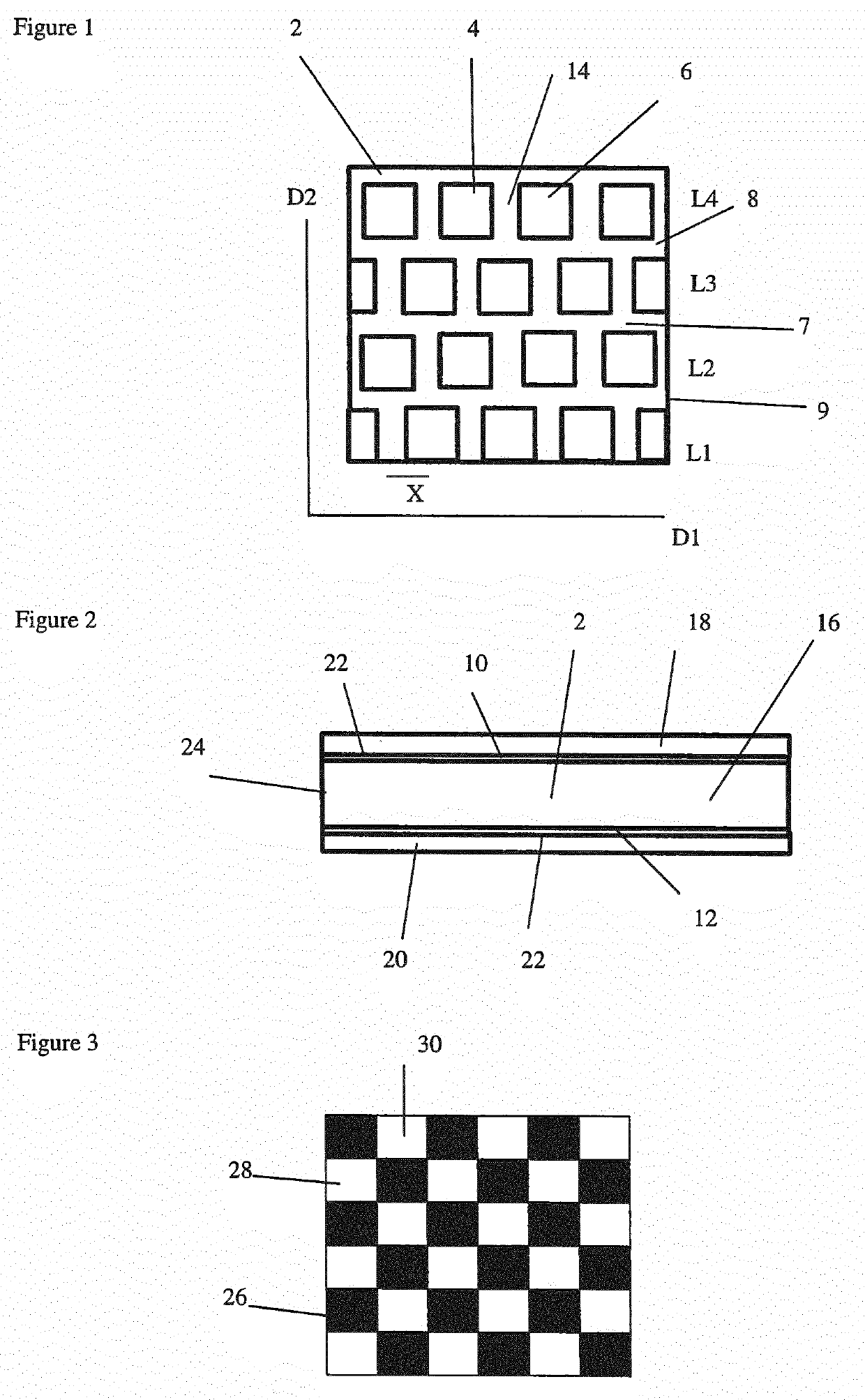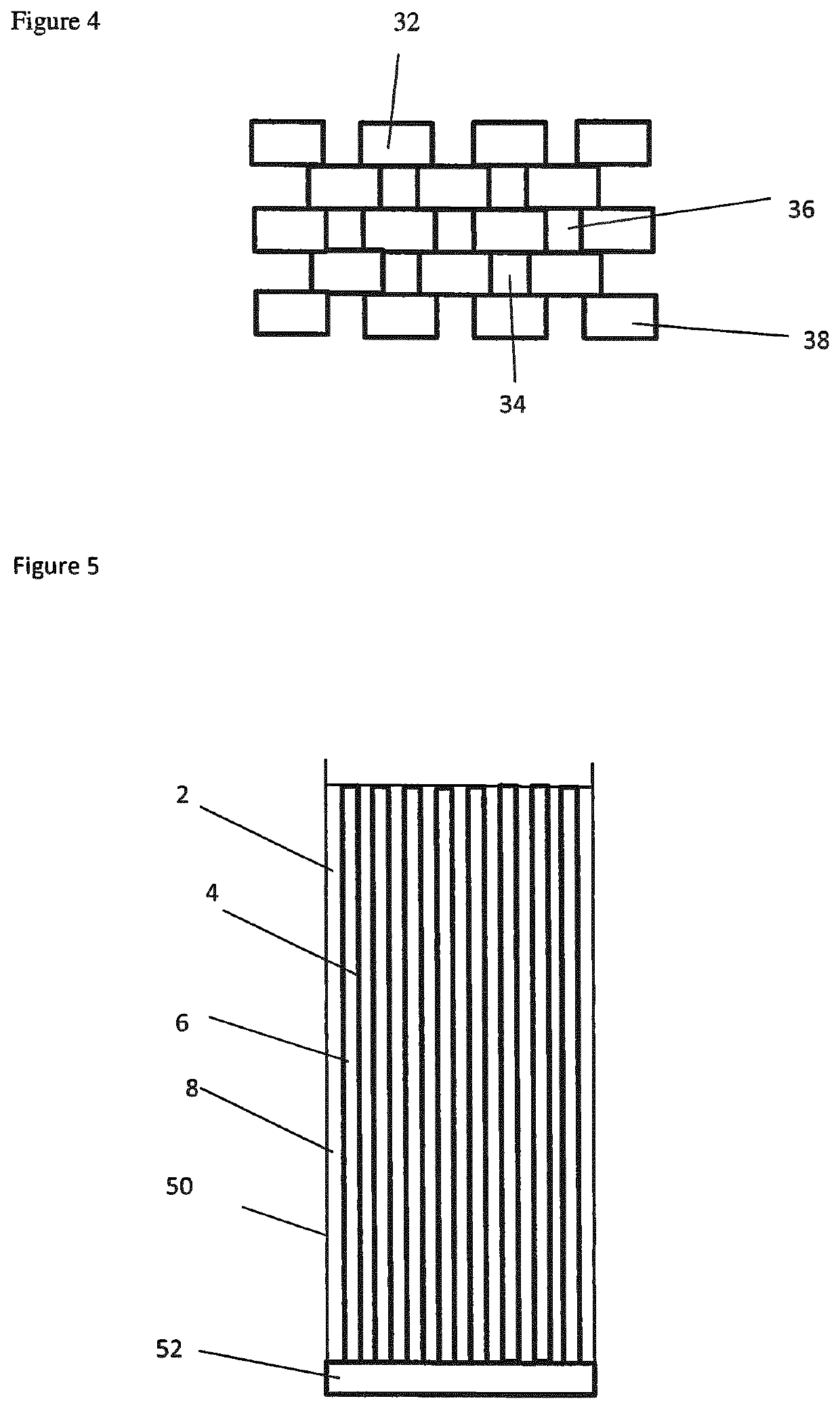Cores for Composite Material Sandwich Panels
a composite material and sandwich panel technology, applied in the field of composite material sandwich panel cores, can solve the problems of difficult to produce balsa cores with highly uniform and predictable engineering properties, uneconomical, and unsatisfactory structural and property uniformity, and achieve uniform properties, increase the uniformity of mechanical properties of the core, and improve the effect of consistent and predictable mechanical properties and performan
- Summary
- Abstract
- Description
- Claims
- Application Information
AI Technical Summary
Benefits of technology
Problems solved by technology
Method used
Image
Examples
example 1
[0063]A balsa core having a cross-section as illustrated in FIG. 1 was provided. The balsa elements had a square cross-section of 20 mm×20 mm. The balsa elements were separated by a foam layer of 10 mm forming a continuous foam matrix. The foam comprised a polyurethane foam having a density of 62 kg / m3. The foam had an elastic modulus (E) of 17 MPa, a shear modulus (G) of 6.3 MPa and a Poisson ratio of 0.35.
[0064]When used to manufacture a wind turbine blade having a main blade portion formed of a 40 mm thickness of the core covered by two opposed outer skins of a single ply of 1200 gsm glass fibre epoxy resin composite, the buckling performance under an applied axial load was determined by finite element analysis (FEA) and quantified as a relative buckling performance (RBP) of 1.
[0065]In contrast, a commercial PVC structural foam having a density of 60 kg / m3, which is sold by the Applicant under the trade name “PVC 60” also has a relative buckling performance (RBP) of 1 but has a h...
example 2
[0067]A balsa core having a cross-section as illustrated in FIG. 3 was provided. The balsa elements had a square cross-section of 20 mm×20 mm. The balsa elements were separated by a foam layer having square regions of 20×20 mm forming a discontinuous foam matrix. The foam comprised a polyurethane foam having a density of 62 kg / m3. The foam had an elastic modulus (E) of 17 MPa, a shear modulus (G) of 6.3 MPa and a Poisson ratio of 0.35.
[0068]When used to manufacture a wind turbine blade having a main blade portion formed of a 40 mm thickness of the core covered by two opposed outer skins of a single ply of 1200 gsm glass fibre epoxy resin composite, the buckling performance under an applied axial load was determined by finite element analysis (FEA) and quantified as a relative buckling performance (RBP) of 1.2. This example provided a similar axial buckling performance as Example 1, but the checkerboard structure of Example 2 has a reduced foam proportion than the header bond structu...
example 3
[0069]A balsa core having a cross-section as illustrated in FIG. 4 was provided. The balsa elements had a rectangular cross-section of 30 mm wide×60 mm long and the foam regions were rectangular with a cross-section of 30 wide×40 mm long forming a discontinuous foam matrix. The foam comprised a polyurethane foam having a density of 62 kg / m3. The foam had an elastic modulus (E) of 17 MPa, a shear modulus (G) of 6.3 MPa and a Poisson ratio of 0.35.
[0070]When used to manufacture a wind turbine blade having a blade root formed of a 25 mm thickness of the core covered by two opposed outer skins of three plies of 1200 gsm glass fibre epoxy resin composite, the buckling performance under an applied transverse load was determined by finite element analysis (FEA) and quantified as a relative buckling performance (RBP) of 3.0.
[0071]In contrast, a commercial PVC structural foam having a density of 60 kg / m3, which is sold by the Applicant under the trade name “PVC 60” had a relative buckling pe...
PUM
| Property | Measurement | Unit |
|---|---|---|
| thickness | aaaaa | aaaaa |
| thickness | aaaaa | aaaaa |
| thickness | aaaaa | aaaaa |
Abstract
Description
Claims
Application Information
 Login to View More
Login to View More - R&D
- Intellectual Property
- Life Sciences
- Materials
- Tech Scout
- Unparalleled Data Quality
- Higher Quality Content
- 60% Fewer Hallucinations
Browse by: Latest US Patents, China's latest patents, Technical Efficacy Thesaurus, Application Domain, Technology Topic, Popular Technical Reports.
© 2025 PatSnap. All rights reserved.Legal|Privacy policy|Modern Slavery Act Transparency Statement|Sitemap|About US| Contact US: help@patsnap.com


